Overview
The article titled "9 Insights on Battery Lifecycle Sustainability Studies" underscores the critical importance of evaluating and enhancing the ecological impacts tied to battery production throughout its lifecycle. It asserts that these sustainability studies are essential for identifying effective strategies aimed at reducing greenhouse gas emissions, improving recycling practices, and encouraging the utilization of sustainable materials. Collectively, these efforts contribute to the development of more environmentally responsible energy storage solutions.
Introduction
In the quest for a sustainable future, the battery industry stands at a critical crossroads, grappling with the environmental and social implications of its production processes. As demand for electric vehicles and renewable energy solutions surges, the need for innovative approaches to battery lifecycle management becomes paramount. Stakeholders are increasingly recognizing the importance of minimizing environmental footprints while maximizing resource recovery.
This article delves into the multifaceted strategies shaping the future of battery sustainability. It explores the pivotal roles of:
- Regulatory frameworks
- Technological innovations
- Social responsibility
in fostering a greener, more efficient energy landscape.
Harbinger Land: Comprehensive Solutions for Land Services in Energy and Infrastructure
Harbinger Land addresses the pressing challenges associated with land services in energy and infrastructure projects across the United States. The complexities of land acquisition, including legal and regulatory hurdles, can hinder progress. Harbinger Land offers comprehensive solutions that encompass:
- Site and right-of-way acquisition
- Advanced title research
- GIS mapping
- Efficient data processing
By leveraging highly integrated GIS modeling services, Harbinger Land facilitates the negotiation and acquisition of leases and easements essential for distributed energy resource (DER) and infrastructure development. This approach not only saves clients time and money but also enhances operational efficiency.
Moreover, their advanced data processing capabilities, utilizing OCR and machine learning, empower clients to quickly identify key information that may impact leasing and development operations. This innovative methodology not only improves efficiency but also elevates client satisfaction. As a result, Harbinger Land positions itself as an indispensable partner for natural gas firms, solar developers, and municipalities engaged in battery lifecycle sustainability studies.
Are you ready to tackle the challenges of land acquisition? Partner with Harbinger Land to navigate the complexities and drive your projects forward.
Life-Cycle Assessment: Evaluating Environmental Impacts of Battery Production
Battery lifecycle sustainability studies provide a comprehensive framework for evaluating the ecological effects associated with cell production, encompassing every phase from raw material extraction to disposal. This method critically assesses factors such as greenhouse gas emissions, energy consumption, and resource depletion.
Recent studies underscore the potential to enhance LCA processes significantly through battery lifecycle sustainability studies, thereby reducing the ecological impact of energy storage production. Notably, the establishment of circular supply chains for lithium-ion cells has been shown to substantially mitigate ecological effects, emphasizing the essential role of battery lifecycle sustainability studies and recycling in sustainable energy solutions.
Furthermore, additional examination of the environmental impacts of disassembling collected cells prior to transport is recommended, as this could reveal further opportunities for improvement in eco-friendly practices.
As the demand for electric vehicles (EVs) escalates, it becomes increasingly crucial to understand the heightened impacts of metal and mineral consumption, along with the potential for human toxicity when compared to internal combustion engine vehicles (ICEVs). Specifically, EVs exhibit a greater impact regarding metal and mineral consumption, necessitating a focus on optimizing plant-scale energy storage refining operations.
The findings from these studies advocate for a stronger emphasis on recyclability in future energy storage designs, which could further enhance sustainability within the energy sector.
Sustainable Materials: Innovations in Battery Design for Reduced Environmental Footprint
Innovations in energy storage design, particularly through the use of sustainable materials, are pivotal in minimizing the environmental impact of these devices. The emergence of solid-state energy storage systems, which promise enhanced safety and efficiency, marks a significant advancement in this field. These power sources not only reduce dependence on conventional materials but also incorporate recycled elements, thereby decreasing the carbon emissions associated with their production.
As Dr. Abniel Machín-De Jesús observes, "The incorporation of eco-friendly methods in energy storage technology is crucial for reducing ecological effects and encouraging a circular economy." The recycling of lithium-ion cells is gaining traction, conserving valuable resources and mitigating environmental harm.
Effective recycling and end-of-life management strategies are essential for the battery lifecycle sustainability studies of solid-state energy storage devices (SSDs), which aim to reduce carbon emissions and combat climate change. With Toyota poised for large-scale manufacturing of solid-state power sources by 2027, the sector is on track for significant progress in environmental responsibility. Such advancements align with global environmental objectives, demonstrating how cutting-edge energy storage technologies can contribute to a more eco-friendly future.
To maximize the benefits of these innovations, stakeholders must prioritize the development of comprehensive recycling initiatives and end-of-life strategies for power storage products.
Recycling Practices: Enhancing Battery Lifecycle Sustainability
Effective recycling methods are essential for enhancing the battery lifecycle sustainability studies of energy storage systems. Techniques such as hydrometallurgical and pyrometallurgical recycling enable the retrieval of precious materials from used cells, significantly reducing the demand for new raw materials.
By 2025, advancements in hydrometallurgical recycling technologies have resulted in increased efficiency, with certain methods achieving recovery rates exceeding 90% for critical materials like lithium and cobalt. Notably, emission removal systems have also demonstrated over 90% total emission elimination, underscoring the importance of integrating emissions reduction strategies into recycling processes. These advancements not only enhance material recovery but also mitigate environmental impacts, positioning recycling as a vital component of eco-friendly management.
For instance, a recent case study showcased a facility that adopted hydrometallurgical processes, achieving a remarkable 98% recovery rate of valuable metals while simultaneously decreasing energy consumption through integrated heat recovery systems. This reflects eco-friendly practices seen in other sectors, such as a vertically integrated convenience store chain that attained over 98% destruction efficiency of ethanol emissions in their bakery operations through the installation of catalytic oxidizers.
As Anguil noted, collaboration with original equipment manufacturers (OEMs) can foster integrated systems that enhance performance and environmental sustainability. As the sector continues to evolve, battery lifecycle sustainability studies will be crucial in securing a sustainable future for energy cell lifecycle management through efficient recycling methods.
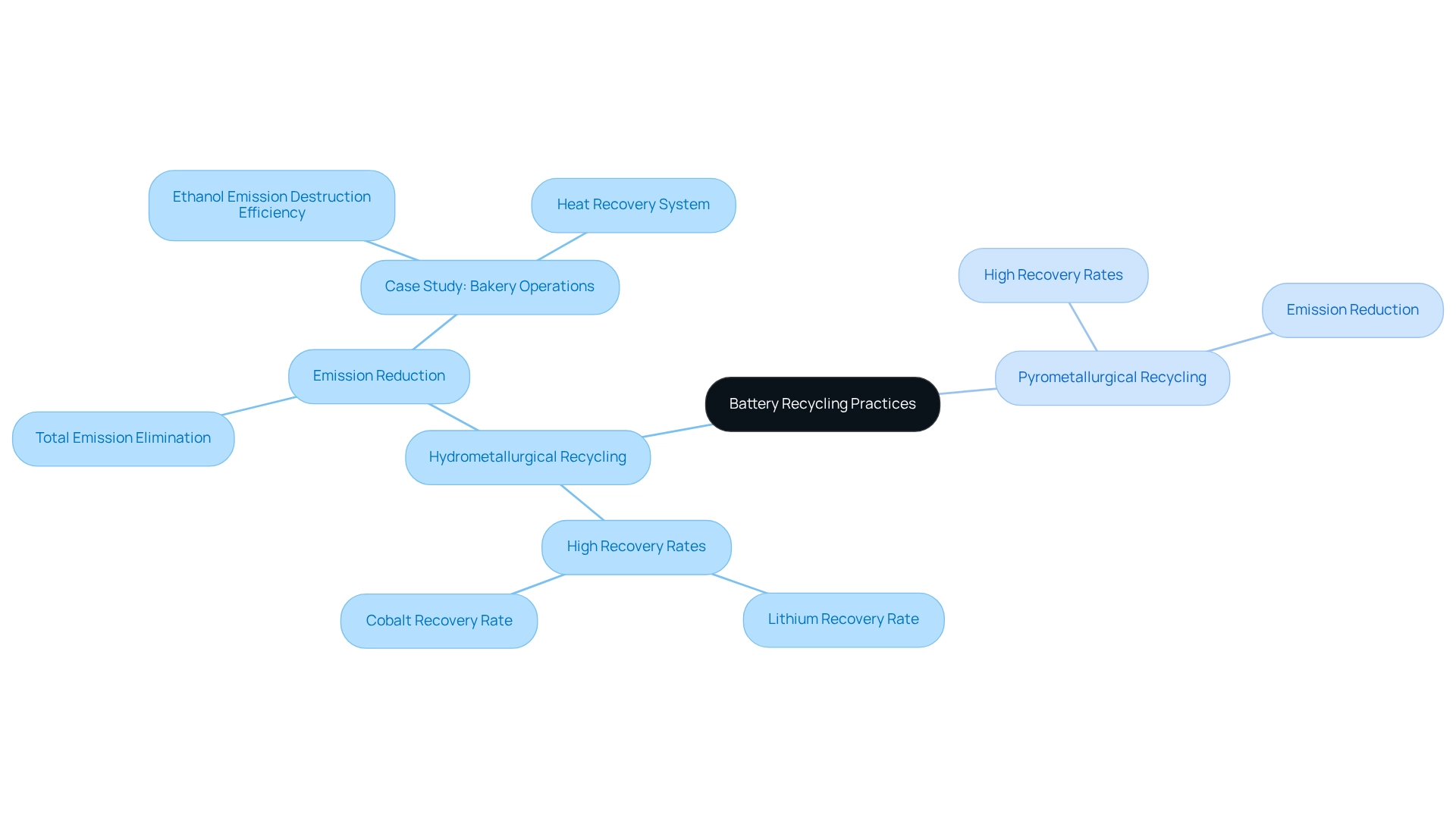
End-of-Life Management: Strategies for Sustainable Battery Disposal
Effective end-of-life management strategies are essential for promoting the sustainable disposal of power sources. Establishing take-back initiatives and adhering to strict recycling procedures significantly mitigates the ecological impact of disposed cells. Successful take-back initiatives demonstrate that when consumers are encouraged to return cells, recycling rates improve, leading to enhanced resource recovery and reduced landfill waste.
Statistics indicate that improper disposal of cells poses considerable environmental risks, with the overall average availability for electric buses at 80.6%, compared to 90.5% for hybrid buses and 86.4% for diesel buses. This highlights the urgent need for robust management practices, especially as the focus on battery lifecycle sustainability studies intensifies in 2025, driven by policies encouraging manufacturers to design these units with end-of-life considerations. This proactive approach not only fosters sustainability but also aligns with emerging regulations aimed at minimizing waste.
Case studies, such as Amazon's pilot program for electrifying their delivery fleet in France, Italy, and Spain, illustrate the significance of integrating end-of-life strategies into broader sustainability efforts. The pilot revealed that efficient power management is vital for achieving emissions reduction goals, as it eliminated all tailpipe emissions and resulted in over 50% fuel savings in Europe. These findings underscore the need for improved charging infrastructure and highlight last-mile delivery as a suitable application for fleet electrification.
Experts assert that take-back programs are pivotal in end-of-life management for energy storage. By facilitating the return of used cells, these initiatives ensure the responsible management of hazardous substances while promoting the recycling of valuable materials. As the industry transitions towards more environmentally friendly practices, battery lifecycle sustainability studies will be critical in shaping the impact of these initiatives on the future of energy storage lifecycle management. Furthermore, the City of Loveland has set a target to convert 100% of its municipal fleet to electric vehicles where heavy use is not required and operations remain within a 35-mile radius of the city. This commitment underscores the importance of sustainable disposal and management practices for power sources. For Directors of Land Acquisition, collaborating with local authorities and stakeholders to advance the establishment of charging infrastructure and take-back initiatives can enhance the longevity of energy storage management in their projects.
Regulatory Frameworks: Driving Sustainability in the Battery Industry
Regulatory structures play a crucial role in advancing eco-friendliness within the power cell sector. Recent guidelines, such as the EU's Batteries Regulation, are designed to ensure that power sources are developed with battery lifecycle sustainability studies in mind throughout their entire lifecycle. These regulations not only encourage manufacturers to embrace eco-friendly practices but also promote recycling and responsible sourcing of materials. Ultimately, they foster a more sustainable energy storage ecosystem, which is essential for a greener future.
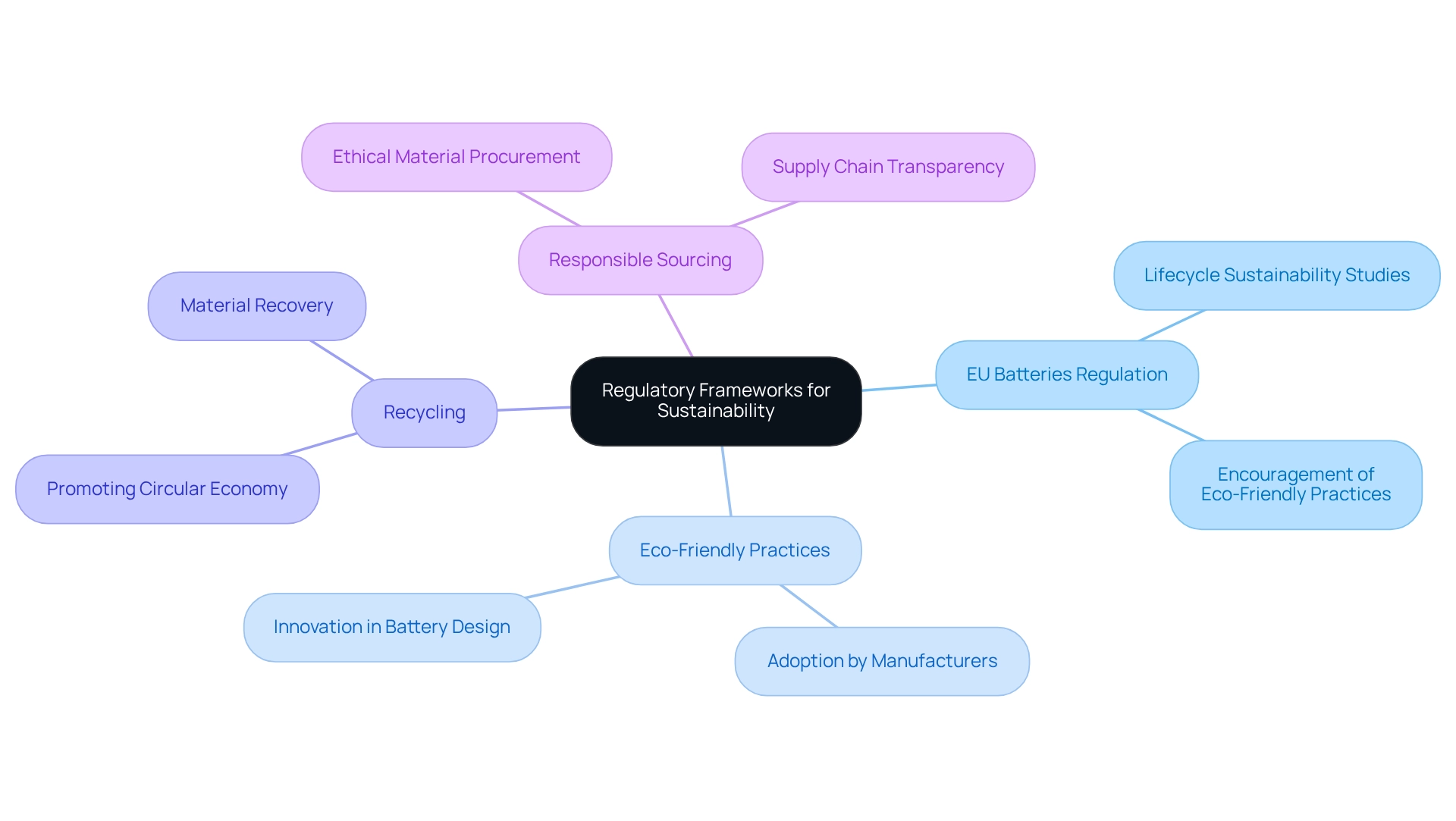
Social Sustainability: Addressing Community and Labor Issues in Battery Production
Social responsibility in energy storage creation is vital for addressing the community and labor issues that arise during production. Companies are increasingly recognizing the importance of fair labor practices, which not only enhance worker rights but also contribute to overall productivity and morale. Recent statistics reveal that during site visits to 17 artisanal mines, processing centers, and trading depots, a significant percentage of laborers reported improved working conditions when companies implement transparent labor policies.
Promoting community involvement is another essential aspect of social sustainability. In 2025, initiatives aimed at engaging local communities in decision-making processes have demonstrated promising results, fostering a sense of ownership and collaboration. This engagement is crucial for mitigating adverse social effects and ensuring that the benefits of production extend beyond factory boundaries. As Johan Rockström emphasized, global sustainability is imperative for progress, and community involvement plays a pivotal role in achieving this, as evidenced by battery lifecycle sustainability studies which show that ethical sourcing remains a cornerstone of sustainable practices within battery supply chains. Companies are encouraged to adopt transparent sourcing strategies that prioritize human rights and ecological stewardship. Insights from industry leaders underscore that ethical sourcing not only cultivates trust with local communities but also bolsters brand reputation and customer loyalty. Amnesty International has highlighted that without proper oversight, it becomes impossible to ascertain whether companies are meeting their human rights obligations, and battery lifecycle sustainability studies, like the Responsible Environment Initiative, illustrate how addressing ecological responsibility and chemical management can lead to improved social outcomes. This initiative develops tools and services designed to enhance environmental performance across industries, which in turn addresses labor issues and promotes community well-being.
In summary, prioritizing social viability in energy cell production is not merely a regulatory requirement; it is a strategic necessity that can drive long-term success and community support. As Anand Mahindra asserts, sustainability is integral to community growth, reinforcing the imperative for companies to engage with and support the communities in which they operate.
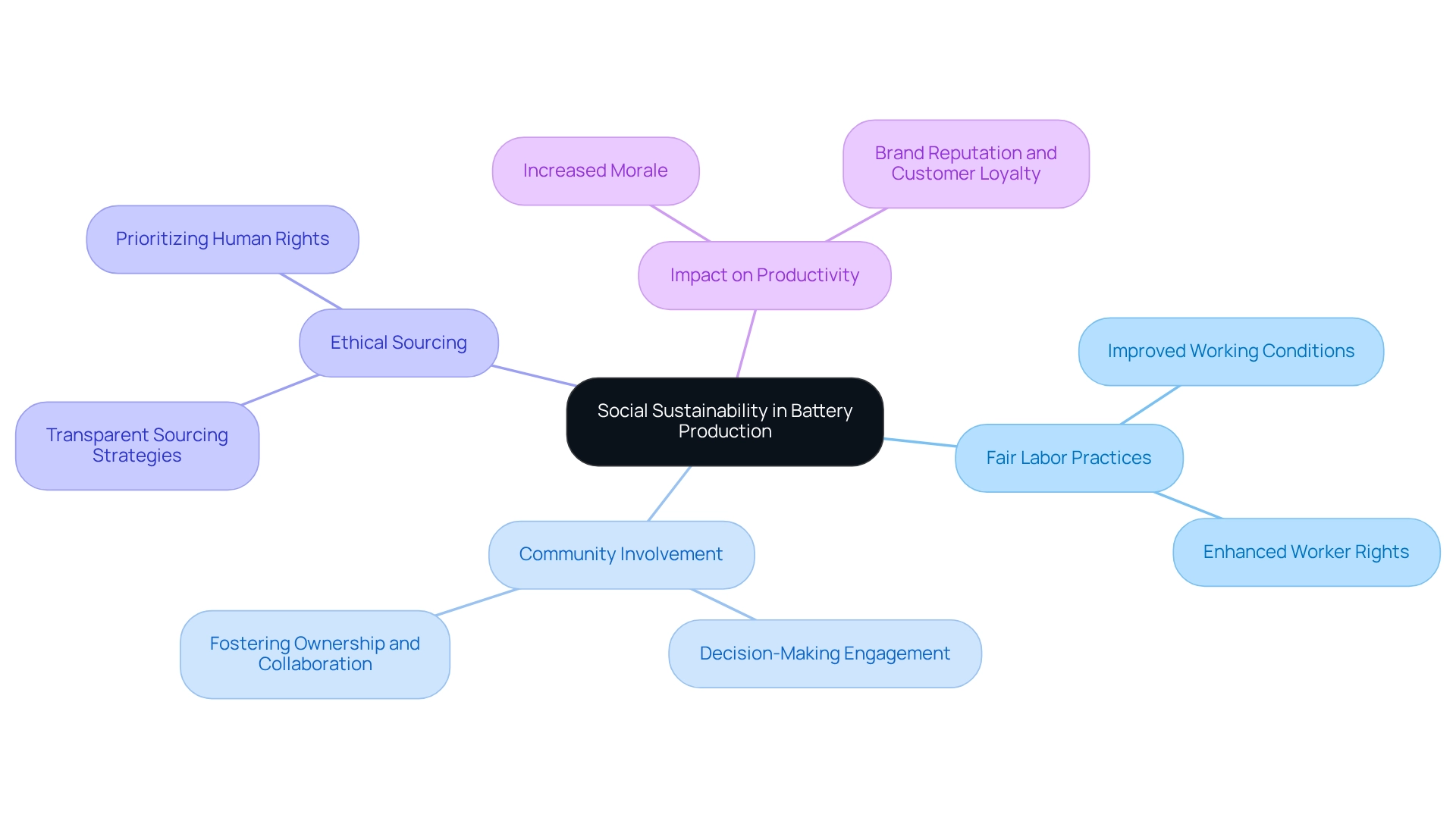
Economic Considerations: Cost-Benefit Analysis of Sustainable Battery Practices
Conducting a cost-benefit analysis of eco-friendly battery practices is not merely beneficial; it is essential for understanding their economic viability. While initial investments in sustainable technologies may appear substantial, the long-term savings achieved through:
- Reduced waste
- Lower energy consumption
- Enhanced brand reputation
can significantly outweigh these costs. Stakeholders must critically assess the financial implications of eco-friendly initiatives. This evaluation is crucial for making informed decisions that align with both economic and environmental objectives.
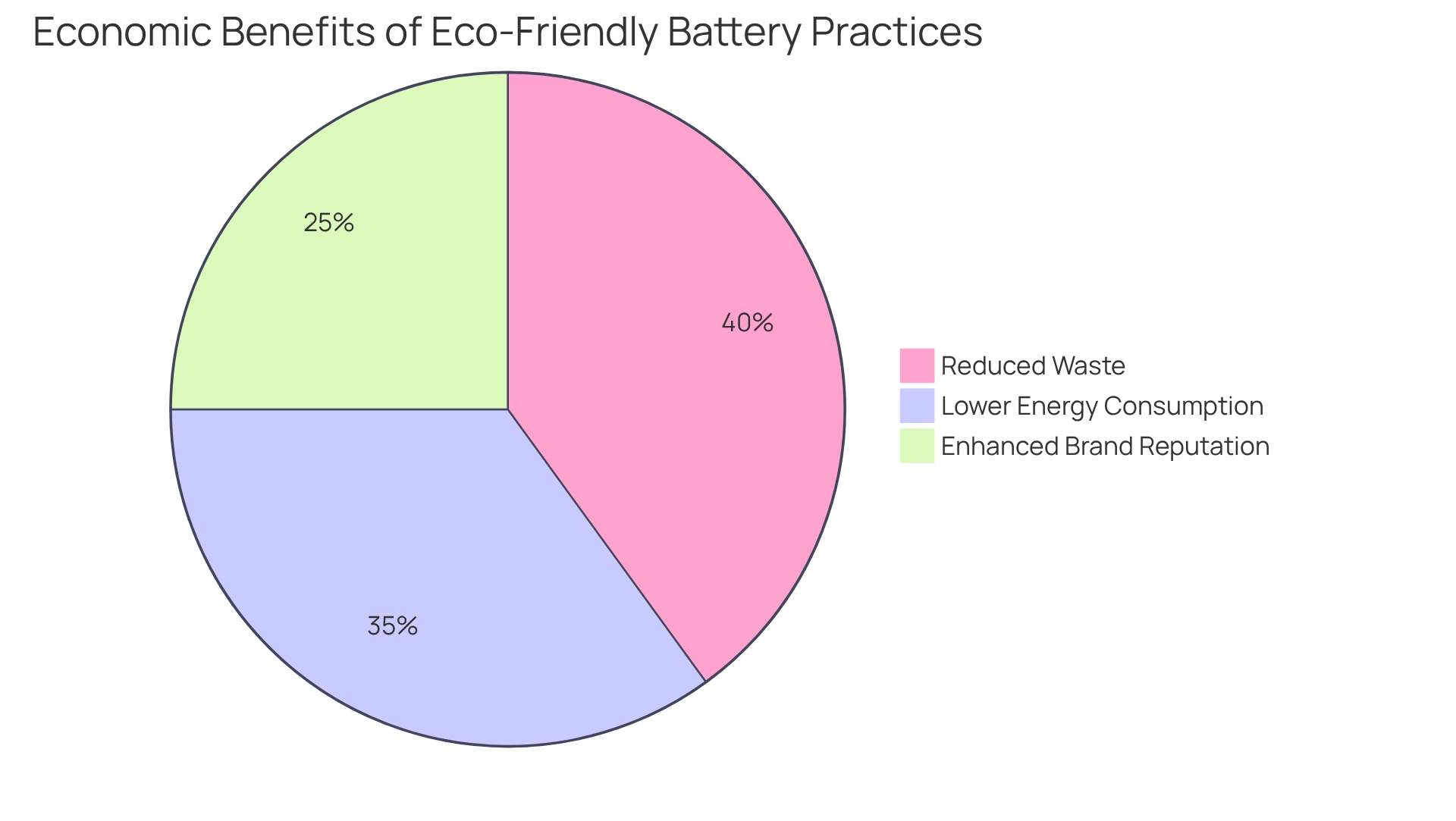
Technological Innovations: Enhancing Battery Efficiency and Sustainability
Technological advancements are pivotal in enhancing energy storage efficiency and sustainability, particularly concerning land acquisition for energy projects. The introduction of solid-state energy storage systems in 2025 is set to revolutionize energy storage, offering greater energy densities and improved safety compared to conventional lithium-ion systems. With the number of electric vehicle platforms expected to double by 2024, the demand for effective energy storage solutions will surge, necessitating strategic land acquisition to support new production facilities.
To optimize production, establishing clear requirements and adopting a Design for Manufacturing (DFM) mindset is essential. This approach helps prevent delivery delays and boosts operational effectiveness, which is crucial for meeting the rising demand for battery lifecycle sustainability studies in sustainable energy storage technologies. Furthermore, advancements in recycling methods are being developed to enhance battery lifecycle sustainability studies by recovering valuable materials, significantly minimizing waste and environmental impact.
AI-driven optimization methods are transforming energy storage production processes, allowing manufacturers to streamline operations and reduce resource consumption. For example, innovations in AI algorithms facilitate real-time monitoring and predictive maintenance, resulting in substantial reductions in production costs and emissions. However, it is important to recognize that multiple production lines for different cell form factors can lead to inefficiencies and larger footprints, complicating land acquisition efforts.
As noted by Peter Adeyemi from ATS Industrial Automation, "We pride ourselves on a set of core qualities that define our workforce and set us apart in the industry." This underscores the importance of innovation and teamwork in advancing eco-friendly power storage technologies.
Case studies, such as the development of the DeepCharge platform, illustrate how innovative strategies can foster collaboration across sectors, ultimately promoting the adoption of sustainable energy storage technologies. These innovations not only enhance performance but also contribute to battery lifecycle sustainability studies, making them vital for the future of energy storage.
Actionable Tips:
- Stay informed about advancements in solid-state energy storage technology and their implications for land acquisition.
- Implement a DFM mindset in project planning to enhance operational efficiency.
- Consider the impact of production line strategies on land requirements to avoid inefficiencies.
Future Trends: The Path Forward for Battery Lifecycle Sustainability
The trajectory of battery lifecycle sustainability studies is increasingly shaped by several pivotal trends. Heightened regulatory oversight compels manufacturers to adopt more transparent and responsible practices, ensuring compliance with ecological standards. Simultaneously, advancements in recycling technologies are revolutionizing the processing of energy storage units at the end of their lifecycle, as highlighted in battery lifecycle sustainability studies, significantly minimizing waste and promoting resource recovery. As the demand for electric vehicles and renewable energy solutions escalates, the storage technology industry confronts the dual challenge of scaling production sustainably, which is informed by battery lifecycle sustainability studies, while mitigating the environmental impact of disposal.
Furthermore, an increasing emphasis on social responsibility is redefining stakeholder expectations, urging companies to prioritize ethical sourcing and community engagement. The successful testing of solid-state energy storage systems by industry leaders such as Nio represents a promising development, potentially alleviating range anxiety and enhancing the appeal of electric vehicles. However, the cost-effectiveness of these innovations remains a pressing concern, as evidenced by the challenges faced in making solid-state energy storage devices accessible to entry-level vehicle categories. A recent case study underscores the necessity for manufacturers to concentrate on cost-effective production methods to tackle this affordability challenge in the market.
Looking ahead to 2025 and beyond, it is imperative for stakeholders to proactively navigate these emerging challenges and opportunities. By embracing eco-friendly methods and fostering innovation, the energy storage sector can secure a robust and environmentally conscious future, as highlighted in battery lifecycle sustainability studies. As Zdeněk Štybar remarked, "Data uplifts performance and condition both for individuals and in cycling overall," a sentiment that resonates within the battery sector where data-driven insights can bolster sustainability efforts. Additionally, with BYD capturing approximately 15% of the lithium-ion market share, the competitive landscape underscores the critical role of market participants in advancing responsible practices. By integrating these elements, the industry can position itself more effectively for a sustainable future.
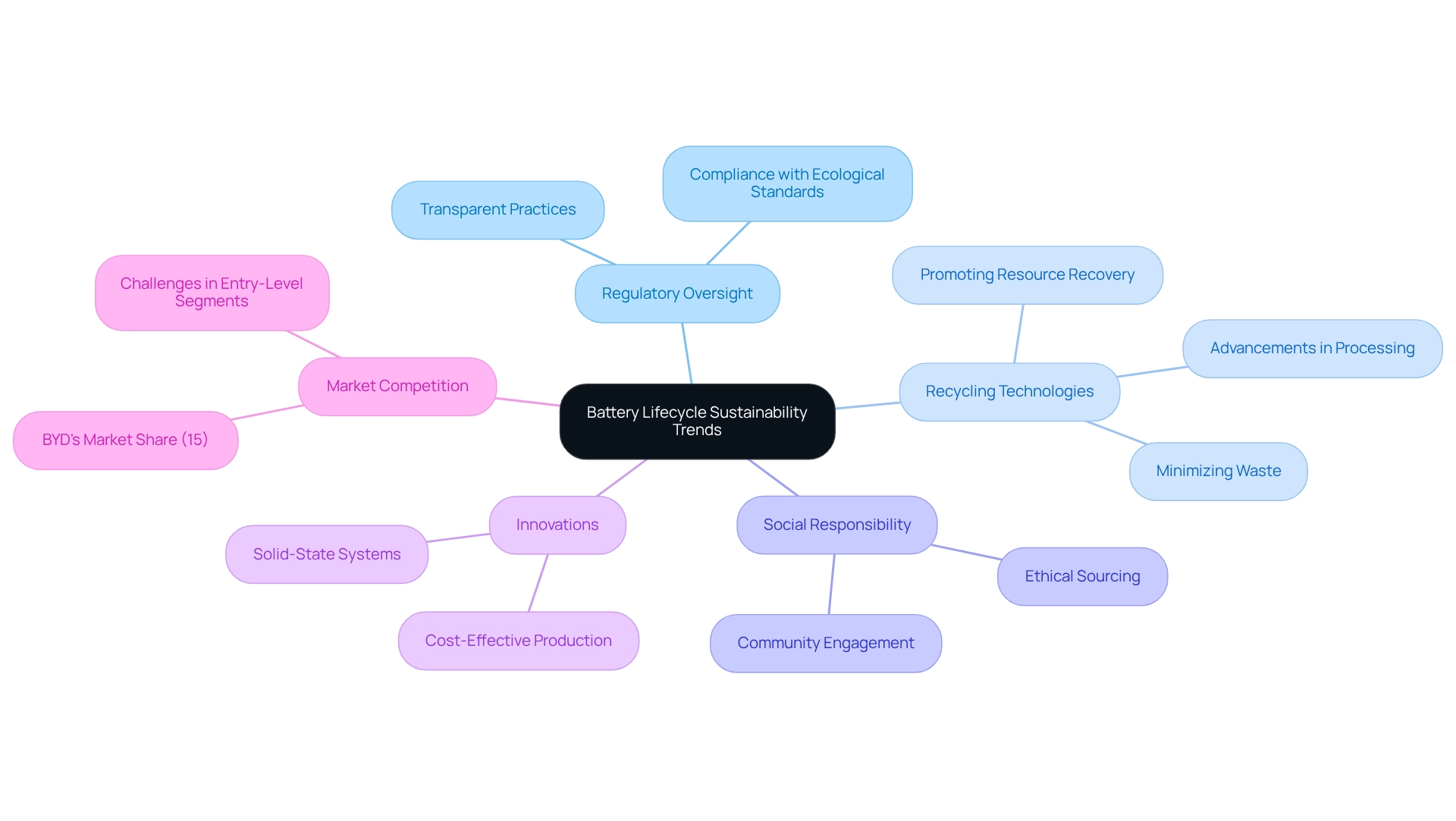
Conclusion
The future of battery lifecycle sustainability is contingent upon a comprehensive approach that integrates regulatory frameworks, innovative technologies, and social responsibility. Regulatory measures, such as the EU's new Batteries Regulation, are crucial in compelling manufacturers to adopt eco-friendly practices throughout the battery lifecycle. This regulatory impetus not only facilitates responsible sourcing and recycling but also fosters a culture of sustainability within the industry.
Innovative technologies, especially in battery design and recycling processes, are vital for minimizing environmental impacts. The rise of solid-state batteries and advancements in recycling technologies exemplify a commitment to waste reduction and enhanced resource recovery. These innovations not only bolster battery efficiency but also align with global sustainability objectives, highlighting the industry's capacity to positively impact environmental conservation.
Furthermore, addressing social sustainability is essential for nurturing community engagement and ethical labor practices in battery production. As companies increasingly emphasize transparency and collaboration with local communities, the advantages of sustainable practices extend beyond manufacturing, contributing to overall community well-being.
As the battery industry continues to evolve, it is imperative for stakeholders to adopt these sustainable practices. By prioritizing innovation, adhering to regulatory frameworks, and embracing social responsibility, the industry can effectively navigate the challenges of scaling production while minimizing environmental impacts. The path forward necessitates a collective effort to ensure that advancements in battery technology not only satisfy the rising demand for electric vehicles and renewable energy solutions but also foster a greener, more sustainable future for all.
Frequently Asked Questions
What challenges does Harbinger Land address in energy and infrastructure projects?
Harbinger Land addresses the pressing challenges associated with land services, particularly the complexities of land acquisition, including legal and regulatory hurdles that can hinder progress.
What services does Harbinger Land offer for land acquisition?
Harbinger Land offers comprehensive solutions that include site and right-of-way acquisition, advanced title research, GIS mapping, and efficient data processing.
How does Harbinger Land utilize GIS modeling services?
Harbinger Land leverages highly integrated GIS modeling services to facilitate the negotiation and acquisition of leases and easements essential for distributed energy resource (DER) and infrastructure development.
What benefits do clients experience by partnering with Harbinger Land?
Clients save time and money and enhance operational efficiency through Harbinger Land's innovative methodologies, which improve efficiency and elevate client satisfaction.
Who can benefit from Harbinger Land's services?
Natural gas firms, solar developers, and municipalities engaged in battery lifecycle sustainability studies can benefit from Harbinger Land's expertise in land acquisition.
What is the focus of battery lifecycle sustainability studies?
Battery lifecycle sustainability studies provide a framework for evaluating the ecological effects associated with cell production, covering aspects from raw material extraction to disposal.
How do battery lifecycle sustainability studies impact energy storage production?
These studies can significantly enhance life cycle assessment (LCA) processes, reducing the ecological impact of energy storage production, particularly through the establishment of circular supply chains for lithium-ion cells.
What environmental impacts are associated with electric vehicles (EVs)?
EVs exhibit a greater impact regarding metal and mineral consumption compared to internal combustion engine vehicles (ICEVs), necessitating a focus on optimizing energy storage refining operations.
What advancements are being made in energy storage design?
Innovations include the use of sustainable materials and the emergence of solid-state energy storage systems, which enhance safety and efficiency while reducing dependence on conventional materials.
How does recycling play a role in energy storage sustainability?
Effective recycling and end-of-life management strategies are essential for solid-state energy storage devices, aiming to reduce carbon emissions and promote environmental responsibility.
What is the future outlook for solid-state power sources?
Companies like Toyota are poised for large-scale manufacturing of solid-state power sources by 2027, indicating significant progress in environmental responsibility within the energy sector.
List of Sources
- Life-Cycle Assessment: Evaluating Environmental Impacts of Battery Production
- A review of the life cycle assessment of electric vehicles: Considering the influence of batteries - PubMed (https://pubmed.ncbi.nlm.nih.gov/34990672)
- Life cycle comparison of industrial-scale lithium-ion battery recycling and mining supply chains - Nature Communications (https://nature.com/articles/s41467-025-56063-x)
- Recycling lithium-ion batteries delivers significant environmental benefits (https://news.stanford.edu/stories/2025/01/recycling-lithium-ion-batteries-cuts-emissions-and-strengthens-supply-chain)
- Sustainable Materials: Innovations in Battery Design for Reduced Environmental Footprint
- Environmental Aspects and Recycling of Solid-State Batteries: A Comprehensive Review (https://mdpi.com/2313-0105/10/7/255)
- Is Lithium Mining Bad For The Environment? Stats And Facts (https://greenmatch.co.uk/blog/is-lithium-mining-bad-for-the-environment)
- Recycling Practices: Enhancing Battery Lifecycle Sustainability
- anguil.com (https://anguil.com/case_studies_category/view-all)
- End-of-Life Management: Strategies for Sustainable Battery Disposal
- EV Case Studies (https://libertyutilities.chooseev.com/commercial/case_studies)
- Social Sustainability: Addressing Community and Labor Issues in Battery Production
- 100+ inspirational and powerful quotes on Sustainability (clustered by topic) - Twenty Now (https://twentynow.com/sustainability-initiatives/sustainability/100-inspirational-and-powerful-quotes-on-sustainability-clustered-by-topic)
- When subterranean slavery supports sustainability transitions? power, patriarchy, and child labor in artisanal Congolese cobalt mining (https://sciencedirect.com/science/article/pii/S2214790X20303154)
- Industry giants fail to tackle child labour allegations in cobalt battery supply chains (https://amnesty.org/en/latest/press-release/2017/11/industry-giants-fail-to-tackle-child-labour-allegations-in-cobalt-battery-supply-chains)
- Responsible Business Alliance (https://responsiblebusiness.org)
- Technological Innovations: Enhancing Battery Efficiency and Sustainability
- Automated Solutions for the Advancement of Small Modular Reactor Technology (https://atsindustrialautomation.com/case_studies/automated-solutions-for-the-advancement-of-small-modular-reactor-technology)
- sprout.cc (https://sprout.cc/work/case_studies/deepcharge)
- Future Trends: The Path Forward for Battery Lifecycle Sustainability
- The best statements from the TAL 2024 conference (https://insights.aimtecglobal.com/en/TAL2024-people-and-data-are-worth-their-weight-in-gold-the-best-quotes-from-the-trends-in-automotive-logistics-conference-2024)
- How Solid-State Batteries Will Revolutionize the Industry (https://apexmechanicalbg.com/the-future-of-electric-vehicles-how-solid-state-batteries-will-revolutionize-the-industry)
- Oct 23, 2024: DHL highlights future trends in the automotive industry and their impact on logistics (https://group.dhl.com/en/media-relations/press-releases/2024/dhl-highlights-future-trends-in-the-automotive-industry-and-their-impact-on-logistics.html)




